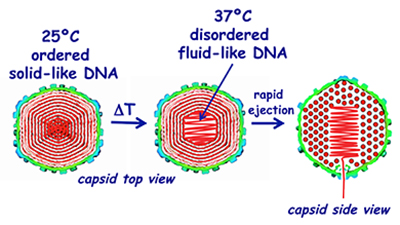Carnegie Mellon Research Shows Viral DNA Infects Cells by Changing from Solid to Fluid-Like State
Viral Infection Might Just Be a Phase Transition
Contact: Jocelyn Duffy / 412-268-9982 / jhduffy@andrew.cmu.edu
 PITTSBURGH—Many double-stranded DNA viruses infect cells by ejecting their genetic information into a host cell. But how does the usually rigid DNA packaged inside a virus' shell flow from the virus to the cell?
PITTSBURGH—Many double-stranded DNA viruses infect cells by ejecting their genetic information into a host cell. But how does the usually rigid DNA packaged inside a virus' shell flow from the virus to the cell?
In two separate studies, Carnegie Mellon University biophysicist Alex Evilevitch has shown that in viruses that infect both bacteria and humans, a phase transition at the temperature of infection allows the DNA to change from a rigid crystalline structure into a fluid-like structure that facilitates infection.
The findings, published in Nature Chemical Biology and the Proceedings of the National Academy of Sciences (PNAS), provide a promising new target for antiviral therapies. Most antiviral drugs work by deactivating viral proteins, but viruses often evolve and become drug resistant. Evilevitch believes that researchers now have a possible new way to prevent infection — blocking the phase transition. Such a therapy could be generalizable across all types of Herpes viruses, and wouldn't be prone to developing resistance.
"The exciting part of this is that the physical properties of packaged DNA play a very important role in the spread of a viral infection, and those properties are universal," said Evilevitch, an associate professor in Carnegie Mellon's Department of Physics. "This could lead to a therapy that isn't linked to the virus' gene sequence or protein structure, which would make developing resistance to the therapy highly unlikely."
Most viruses, whether they infect bacteria, plants or animals, have fairly similar structures. They consist of an outer shell called a capsid that contains the viral genome — either DNA or RNA. In many DNA viruses the long strands of nucleic acid are tightly wound in a crystalline structure. The repulsive forces formed by the layered strands of genetic material exert a large amount of pressure on the capsid, and according to previous research done by Evilevitch, this pressure is ultimately what propels DNA out of a small porthole in the virus's capsid and into a host cell. That hole is no larger than the width of a DNA chain.
In order to find out how DNA could easily escape through such a tiny opening in the capsid, Evilevitch did separate studies on Herpes Simplex virus type 1 (HSV-1), which infects humans, and bacteriophage lambda, which infects bacteria.
 In the HSV-1 study, which was published in Nature Chemical Biology, Evilevitch set out to see what physical conditions lead to successful viral infection. Using atomic force microscopy and small angle x-ray scattering (SAXS), he found that both ionic conditions in the cell and temperature could change the fluidity and mobility of the DNA inside a virus. The viral DNA was much more fluid at temperatures close to that of infection (37 degrees Celsius) and at ionic conditions similar to that of neuronal and epithelial cells — the same cells that HSV-1 infects.
In the HSV-1 study, which was published in Nature Chemical Biology, Evilevitch set out to see what physical conditions lead to successful viral infection. Using atomic force microscopy and small angle x-ray scattering (SAXS), he found that both ionic conditions in the cell and temperature could change the fluidity and mobility of the DNA inside a virus. The viral DNA was much more fluid at temperatures close to that of infection (37 degrees Celsius) and at ionic conditions similar to that of neuronal and epithelial cells — the same cells that HSV-1 infects.
In the bacteriophage lambda study, which was published in PNAS, Evilevitch used ultra-sensitive microcalorimetry and SAXS to confirm that there was a solid to fluid-like DNA phase transition in the bacteriophage. They found that at the temperature of infection the phage's DNA underwent a solid-to-fluid-like disordering, which resulted in increased DNA mobility and subsequent cell infection.
The research published in Nature Chemical Biology was supported by the Swedish Research Council (VR), the National Science Foundation (CHE-1152770), the National Institutes of Health (AI060836), and the McWilliams Fellowship at Carnegie Mellon. Co-authors include Udom Sae-Ueng and Dong Li at Carnegie Mellon; Xiaobing Zuo at Argonne National Laboratory; Jamie B. Huffman and Fred L. Homa at the University of Pittsburgh; and Donald Rau at the National Institutes of Health.
The research published in PNAS was supported by the Swedish Research Council and the National Science Foundation (CHE-1152770). Co-authors include Ting Liu, Udom Sae-Ueng, Dong Li and Ivetta Shefer at Carnegie Mellon; Gabriel C. Lander at The Scripps Research Institute; Xiaobing Zuo at Argonne National Laboratory; Bengt Jönsson at Lund University; and Donald Rau at the National Institutes of Health.
###
CMU's Alex Evilevitch (pictured above) and team of researchers have made an exciting discovery in the role that DNA plays in the spread of a viral infection. Their findings could lead to an antiviral therapy that wouldn't be prone to developing drug resistance.
(Bottom photo) Single-molecule measurements made by CMU researchers show that HSV-1 DNA undergoes a solid-to-fluid transition within the capsid.